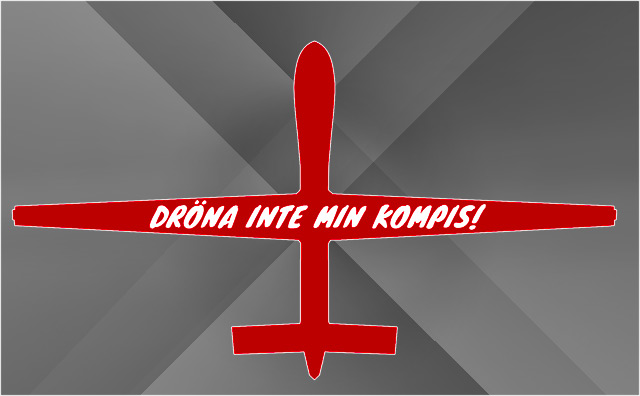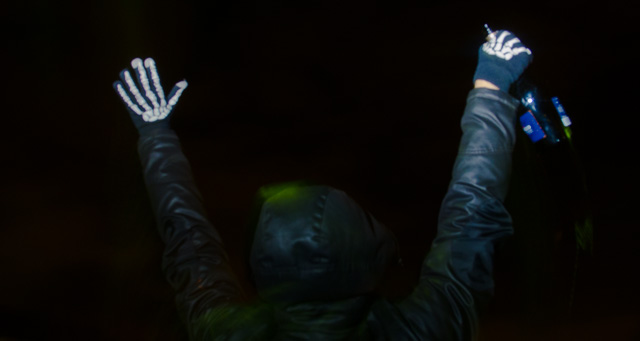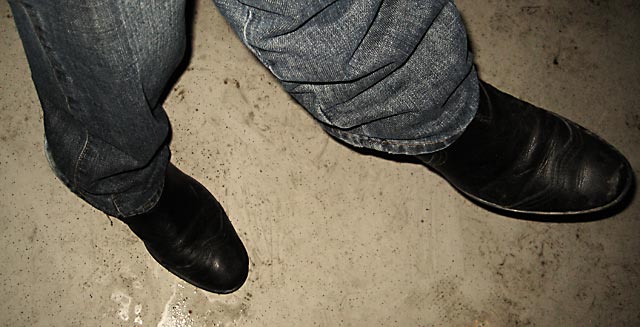It’s so tempting to see the proliferation of drones as a linear progression of sci-fi predictions, and on the surface of it it’s not difficult to imagine that drones will be as omnipresent as CCTV cameras, but what is lacking in that image is how it feels to live under such conditions. We can get a certain notion of the feeling by reading reports from war zones. There, drones are a constant presence with utterly opaque behaviour and motivations which causes enormous stress on everyone, since you never know if you’re being observed or potentially targeted for a killing, Or if you’re neighbour is.
In a non-military settings, I imagine that one might develop a habit of not looking into the sky as often, lest you be reminded of something looking back.
So this weeks project is an idea concocted in mirth but earnest in intent. “Ha ha only serious” as it were. Over beers I and Gabriel started laughing over my suggestion of a paraphrase of the “SOS Racisme” badge, which in Swedish had the text “Rör inte min kompis!” – “Don’t touch my friend!” I proposed a version for our modern times, adapted to the surveillance state as it’s embodied through drones. The text invents a new Swedish verb, and translates loosely to “don’t drone my friend!” Behold:

What the verb “dröna” in this sentence means could refer to raising awareness of the ubiquitous drone killings, as well as the panopticon-like surveillance they’re a part of, or perhaps it’s an appeal: —Friend, don’t drone! The enamel pin will be slightly wider than 5 centimeters, and depending on the colours I can get I’m leaning towards the red-cross red in the image above. Once they’re manufactured I’ll probably setup a subdomain and sell those, or something. What does one do with 200 pins anyway? I’m open for suggestions.
I’ve sent off requests to three manufacturers to get a quote on production, and this is my first venture into ordering to spec through alibaba.com, which is an OEM broker dealing mostly with Chinese manufacturers. Seeing as artists are supposed to be free agents in a free market, this way my Factory is an actual factory. It’s an odd world.
Strictly speaking, this project doesn’t fulfil the “finish by Sunday evening” criteria I set up last week since I don’t have the pins yet. But in my mind it’s finished enough that I can let it go; there’s nothing in the project awaiting my input until I get the quotes and technical specifications on how to deliver the original model. It’s happening, so I’ll count this as a partial success as far as my work ethic goes, awaiting the results once the pins are done and delivered. Their distribution will most likely bloat into a project of it’s own.
Regardless, next week there’ll be another project, perhaps more modest in scale…


Our ancestors could spot natural predators from far by their silhouettes. Are we equally aware of the predators in the present-day? […] This document contains the silhouettes of the most common drone species used today and in the near future. Each indicating nationality and whether they are used for surveillance only or for deadly force. All drones are drawn in scale for size indication. From the smallest consumer drones measuring less than 1 meter, up to the Global Hawk measuring 39,9 meter in length.
→ Drone Survival Watch: Twenty-first century birdwatching
Welcome to Global Drones Watch. The purpose of this site is to provide useful information about drones, and to encourage people to become active in efforts to stop killer drones overseas and stop domestic drones from violating our privacy and safety.
→ Global Drones Watch: Welcome to Global Drones Watch!
In the United States, the dominant narrative about the use of drones in Pakistan is of a surgically precise and effective tool that makes the US safer by enabling “targeted killing” of terrorists, with minimal downsides or collateral impacts. This narrative is false.[…] Based on extensive interviews with Pakistanis living in the regions directly affected, as well as humanitarian and medical workers, this report provides new and firsthand testimony about the negative impacts US policies are having on the civilians living under drones.
→ Stanfort/NYU Report: Living under drones
Schmitt saw with prescient clarity that air war would not only create an “intensification of the technical means of destruction” and the “disorientation of space,” but also intensify the problem of unequal sides, and allow the dominant side to re-label enemies as criminals. Schmitt understood that air power would create a world in which those who command the sky could police and punish those who do not.
→ Boston Review, Nasser Hussain: The sound of terror: Phenomenology of a drone strike


The drones were terrifying. From the ground, it is impossible to determine who or what they are tracking as they circle overhead. The buzz of a distant propeller is a constant reminder of imminent death. Drones fire missiles that travel faster than the speed of sound. A drone’s victim never hears the missile that kills him.
→ Reuters Magazine, David Rohde: The drone wars
“I arrived to the site and there were bodies scattered all over the place. The people told me that my son Aref had died.” When he returned to the village, Al Shafe-ee was quoted as saying, “I saw the women of the village gathered crying and screaming.”
→ NBC News, Michael Isikoff: US investigates Yemenis charge that drone strike “turned wedding into a funeral”
“After an engagement, we have to conduct surveillance for quite a long time. Yes, we may only be seeing it, but sometimes, we’re seeing it for hours on end, and that is part of the traumatic impact of the mission. It’s a definite form of stress on the operator in and of itself.”
→ Live science, Denise Chow: Drone Wars: Pilots reveal debilitating stress beyond virtual battlefield
“Gorgon Stare will be looking at a whole city, so there will be no way for the adversary to know what we’re looking at, and we can see everything.”
→ Washington post, Ellen Nakashima: With air forces Gorgon Drone ‘we can se everything’
“[Depicted on the shield of Agamemnon:] And he took up the man-enclosing elaborate stark shield, a thing of splendour. There were ten circles of bronze upon it, and set about it were twenty knobs of tin, pale-shining, and in the very centre another knob of dark cobalt. And circled in the midst of all was the blank-eyed face of the Gorgo with her stare of horror, and Deimos (Fear) was inscribed upon it, and Phobos (Terror).”
→ The Iliad, Homer: The gorgeneion, image of terror

Another part of the arsenal are drones that will be, for the first time, monitoring the Games from above, as well as robotic bomb detectors that will prowl the Olympic grounds below.[…]”You can’t use drones to prevent suicide bombers … But they’re very good things to prevent [protests] because it might spot people trying to gather.”
→ CBC, Nahlah Ayed: Russia’s olympic security to set new surveillance standard at Sochi
If you’re going to develop secret airplanes, you’re going to need to figure out how to fund them. Now, how do you fund an airplane in secret when the constitution states that all federal funding needs to be accounted for? The point being that there are enormous economic, social and political infrastructures that need to be in place to create and sustain something like classified flight testing. Over time, when you build these types of infrastructures, you end up developing a state within the state that has very different rules and different ways of operating than what we would think of as a kind of democratic state.
→ Center for the study of the drone, Lenny Simon: Interview: Trevor Paglen
I like to think
(it has to be!)
of a cybernetic ecology
where we are free of our labors
and joined back to nature,
returned to our mammal
brothers and sisters,
and all watched over
by machines of loving grace.
→ Richard Brautigan: All watched over by machines of loving grace





